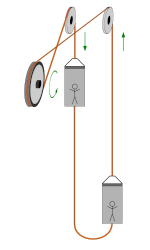Koepe-Winder
Friction hoist - Koepe hoist

A technical innovation with worldwide effect was invented at the Zeche Hannover, the so-called Koepe-Förderung (Koepe-winder). Carl Friedrich Koepe was the director of the mine, and he developed a new system for the mine elevator. Previously a single cage was mounted at the end of the steel cable, the steam engine had to lift the cable, the cage, and the payload. By using two cages, fixed at the opposite ends of a single cable which was running around the hoisting drum, the weight of the cages was neutralized. A second rope, fixed at the bottom of the cages and hanging free, neutralized the weight of the changing amount of rope. As a result, only the weight of the payload had to be lifted, much less energy was needed, and the rope was much less abraded, it had a much longer service life and the danger of a tearing of the rope much lower.
Carl Friedrich Koepe started as a miner and hauler in the Ibbenbüren mine in the Teutoburg Forest. He attended the Märkische Bergschule in Bochum and then worked as a pit foreman and machine foreman at various coal mines in Ibbenbüren and in the Ruhr region. From 1873 he was the technical director of various collieries of the Krupp group. In 1876/1877 he developed the driving-wheel hoisting system, which got him into trouble with the company management. They did not recognize the value of the invention and even let the patent, which had been ceded to them, lapse. Nevertheless, or perhaps precisely because of this, the process became established worldwide and revolutionized the entire shaft-hoisting technology. Koepe hoisting and Koepe pulley have not only entered the miners’ language, they are still established technical terms today.
 Cliffs Shaft Mine Museum, U.S.A.
Cliffs Shaft Mine Museum, U.S.A. Industriemuseum Zeche Hannover, Germany
Industriemuseum Zeche Hannover, Germany Search DuckDuckGo for "Koepe-Winder"
Search DuckDuckGo for "Koepe-Winder" Hoist (mining) - Wikipedia (visited: 26-JUN-2022)
Hoist (mining) - Wikipedia (visited: 26-JUN-2022) Definition of Koepe winder - mindat.org (visited: 26-JUN-2022)
Definition of Koepe winder - mindat.org (visited: 26-JUN-2022)
 Index
Index Topics
Topics Hierarchical
Hierarchical Countries
Countries Maps
Maps